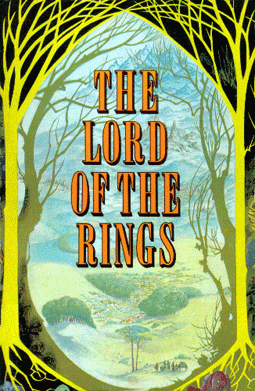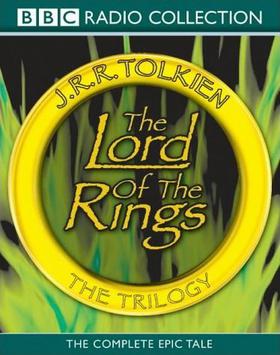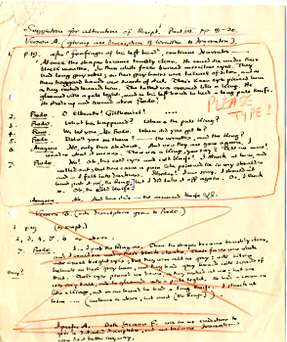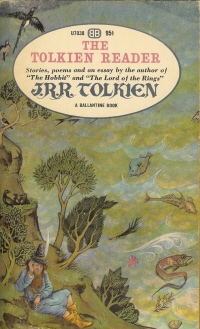Related Research Articles

The Lord of the Rings is an epic high fantasy novel by the English author and scholar J. R. R. Tolkien. Set in Middle-earth, the story began as a sequel to Tolkien's 1937 children's book The Hobbit, but eventually developed into a much larger work. Written in stages between 1937 and 1949, The Lord of the Rings is one of the best-selling books ever written, with over 150 million copies sold.

Bilbo Baggins is the title character and protagonist of J. R. R. Tolkien's 1937 novel The Hobbit, a supporting character in The Lord of the Rings, and the fictional narrator of many of Tolkien's Middle-earth writings. The Hobbit is selected by the wizard Gandalf to help Thorin and his party of Dwarves to reclaim their ancestral home and treasure, which has been seized by the dragon Smaug. Bilbo sets out in The Hobbit timid and comfort-loving, and through his adventures grows to become a useful and resourceful member of the quest.

Tom Bombadil is a character in J. R. R. Tolkien's legendarium. He first appeared in print in a 1934 poem called "The Adventures of Tom Bombadil", which also included The Lord of the Rings characters Goldberry, Old Man Willow and the Barrow-wight, from whom he rescues the hobbits. They were not then explicitly part of the older legends that became The Silmarillion, and are not mentioned in The Hobbit.
Goldberry is a character from the works of the author J. R. R. Tolkien. She first appeared in print in a 1934 poem, The Adventures of Tom Bombadil, where she appears as the wife of Tom Bombadil. Also known as the "River-woman's daughter", she is described as a beautiful, youthful woman with golden hair. She is best known from her appearance as a supporting character in Tolkien's high fantasy epic The Lord of the Rings, first published in 1954 and 1955.

The Adventures of Tom Bombadil is a 1962 collection of poetry by J. R. R. Tolkien. The book contains 16 poems, two of which feature Tom Bombadil, a character encountered by Frodo Baggins in The Lord of the Rings. The rest of the poems are an assortment of bestiary verse and fairy tale rhyme. Three of the poems appear in The Lord of the Rings as well. The book is part of Tolkien's Middle-earth legendarium.
In J. R. R. Tolkien’s fictional universe of Middle-earth, the Old Forest was a daunting and ancient woodland just beyond the eastern borders of the Shire. Its first and main appearance in print was in the chapter of the 1954 The Fellowship of the Ring titled "The Old Forest". The hobbits of the Shire found the forest hostile and dangerous; the nearest, the Bucklanders, planted a great hedge to border the forest and cleared a strip of land next to it. A malign tree-spirit, Old Man Willow, grew beside the River Withywindle in the centre of the forest, controlling most of it.

In 1981, BBC Radio 4 produced a dramatisation of J. R. R. Tolkien's The Lord of the Rings in 26 half-hour stereo instalments. The novel had previously been adapted as a 12-part BBC Radio adaptation in 1955 and 1956, and a 1979 production by The Mind's Eye for National Public Radio in the US.
The following outline is provided as an overview of and topical guide to the real-world history and notable fictional elements of J. R. R. Tolkien's fantasy universe. It covers materials created by Tolkien; the works on his unpublished manuscripts, by his son Christopher Tolkien; and films, games and other media created by other people.

During 1955 and 1956, a condensed radio dramatisation of The Lord of the Rings was broadcast in twelve episodes on BBC Radio's the Third Programme. These radio broadcasts were the first dramatisation of The Lord of the Rings, a book by J. R. R. Tolkien, the final volume of which, The Return of the King, had been published in October 1955. Since the BBC did not generally keep long-term archives of its productions at that time, no copies of the full adaptation are known to have survived. A single clip from a 2016 radio special by BBC Sounds can be heard around the four-minute mark of the recording playing the opening theme of the series. Although virtually all audio of the series is lost, and the script too had been thought lost, in 2022 the Tolkien scholar Stuart Lee rediscovered the full script for the dramatization in the BBC archives, including annotations by Tolkien himself. Lee's research on the script was published as an essay in The Great Tales Never End: Essays in Memory of Christopher Tolkien (2022).

The Tolkien Reader is an anthology of works by J. R. R. Tolkien. It includes a variety of short stories, poems, a play and some non-fiction. It compiles material previously published as three separate shorter books, together with one additional piece and introductory material. It was published in 1966 by Ballantine Books in the USA.
Many adaptations of The Lord of the Rings, an epic by the English author J. R. R. Tolkien, have been made in the media of film, radio, theatre, video games and recorded readings.
The first authorised adaptation of J. R. R. Tolkien's 1937 novel The Hobbit was a stage production by St. Margaret's School, Edinburgh in March 1953. Subsequently, The Hobbit has been adapted for a variety of media including stage, screen, radio, board games and video games.

In J. R. R. Tolkien's fantasy The Lord of the Rings, Old Man Willow is a malign tree-spirit of great age in Tom Bombadil's Old Forest, appearing physically as a large willow tree beside the River Withywindle, but spreading his influence throughout the forest. He is the first hostile character encountered by the Hobbits after they leave the Shire.
Frodo Baggins is a fictional character in J. R. R. Tolkien's writings, and one of the protagonists in The Lord of the Rings. Frodo is a hobbit of the Shire who inherits the One Ring from his cousin Bilbo Baggins, described familiarly as "uncle", and undertakes the quest to destroy it in the fires of Mount Doom in Mordor. He is mentioned in Tolkien's posthumously published works, The Silmarillion and Unfinished Tales.

The Fellowship of the Ring is the first of three volumes of the epic novel The Lord of the Rings by the English author J. R. R. Tolkien. It is followed by The Two Towers and The Return of the King. The action takes place in the fictional universe of Middle-earth. The book was first published on 29 July 1954 in the United Kingdom. The volume consists of a foreword, in which the author discusses his writing of The Lord of the Rings, a prologue titled "Concerning Hobbits, and other matters", and the main narrative in Book I and Book II.
The Mind's Eye was a publisher which produced dramatized adaptations of various written works. They were one of America’s biggest audio drama producers during the 1980s. They had mainstream distribution through chains like Waldenbooks and catalogs like Wireless, and they published an expansive catalog of adaptations of classic stories. They are most notable for the 1979 National Public Radio radio drama version of J.R.R. Tolkien's The Lord of the Rings and for the 1980 version of The Hobbit. Prominent contributors included Bernard Mayes, Erik Bauersfeld, John Vickery, Lou Bliss, Gail Chugg, Tom Luce, Ray Reinhardt, James Arrington, Pat Franklyn, Wanda McCaddon, Rick Cimino, Joe Gostanian, John Joss, Karen Hurley, Kevin Gardiner, Darryl Ferreira, and Carl Hague. The company was acquired by Soundelux in 1992.

Hobitit is a nine-part Finnish live action fantasy television miniseries directed by Timo Torikka, originally broadcast in 1993 on Yle TV1.

Khraniteli is a Soviet television play miniseries based on J. R. R. Tolkien's The Fellowship of the Ring. It was broadcast once in 1991 by Leningrad Television and then thought lost before being rediscovered in 2021. It includes scenes of Tom Bombadil and Goldberry that were omitted from the 1978 film and Peter Jackson's Lord of the Rings film trilogy.

Scholars, including psychoanalysts, have commented that J. R. R. Tolkien's Middle-earth stories about both Bilbo Baggins, protagonist of The Hobbit, and Frodo Baggins, protagonist of The Lord of the Rings, constitute psychological journeys. Bilbo returns from his journey to help recover the Dwarves' treasure from Smaug the dragon's lair in the Lonely Mountain changed, but wiser and more experienced. Frodo returns from his journey to destroy the One Ring in the fires of Mount Doom scarred by multiple weapons, and is unable to settle back into the normal life of his home, the Shire.
References
- 1 2 3 "Mind's Eye The Lord of the Rings (1979)". SF Worlds. 31 August 2014. Retrieved 15 April 2020.
- ↑ "Lord of the Rings Radio Drama". audiotheater.com. Archived from the original on 8 February 2008.
- ↑ "Lord of the Rings (Wood Gift Box Edition) by J.R.R. Tolkien - NPR Dramatization - HighBridge Audio". highbridgeaudio.com. Retrieved 15 April 2020.
